Mary Quattlebaum's Blog, page 7
June 26, 2017
Dramatic Histories & The "Write" Stuff
by Jacqueline Jules
“If we can’t agree on anything, how can we stay one country?”“But we could have even bigger problems, if we break apart.”
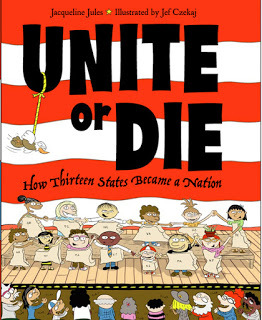
In my book, Unite or Die: How Thirteen States Became a Nation, the students of the imaginary school of Forest Lake Elementary perform a play about the 1787 Constitutional Convention. It is a story which unfolds during a very hot summer in Philadelphia at Independence Hall. Fifty-Five delegates argued bitterly over representation in Congress and at one point, it looked like the convention would break apart. Benjamin Franklin called for prayer and it was said that George Washington looked as glum as he did during the dark days at Valley Forge. The stakes were high. The fledging country was on the brink of collapse. If the delegates had not come up with a compromise, America would not be the nation of fifty states it is today.
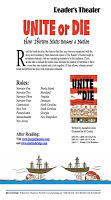
The conflicts and compromises of the Constitutional Convention provide a wealth of material for theatrical performance. For a short version of Unite or Die: How Thirteen States Became a Nation, please check out the Reader’s Theater available at this link.
American history is filled with dramatic moments suitable for reader’s theater. And online resources at The National Archives offer primary documents for your students to research and write their own dramatic sketches. Here are some writing ideas with corresponding links.
Idea # 1: The National Archives has a copy of Eleanor Roosevelt’s famous resignation from the Daughters of the American Revolution over their refusal to hold a concert with Marian Anderson at Constitution Hall. A letter in response from the DAR is also available at this link along with information about the historic concert on Easter Sunday in 1939 when Marian Anderson sang to a crowd of 75,000 people at the steps of the Lincoln Memorial. After examining these primary documents, students could write a radio play with characters playing the part of Mrs. Roosevelt, the DAR president, and Marian Anderson. Reactions from the press and the public could be included.
Idea #2: Transcripts of the Lunar Orbit of Apollo 8 in 1968 are also available online at The National Archives . Students could write an interview with the astronauts describing what they saw and how they felt based on these eyewitness documents.
Idea #3: Susan B. Anthony surprised the registrar in Rochester, New York when she showed up demanding to vote in the 1872 presidential election. The National Archives has primary documents of the hearing which took place after her arrest. Students could re-enact Susan B. Anthony’s historic arrest based on those transcripts.
The Library of Congress also has wonderful resources for primary research. Creating a dramatic sketch based on historical documents is an exciting way to combine research and writing skills.
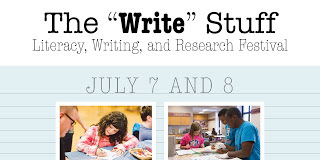 https://www.archivesfoundation.org/ev... great opportunity for enhancing those skills will be available at a free literary festival called THE “WRITE” STUFF which will take place at The National Archives this summer on July 7 and 8, 2017.
https://www.archivesfoundation.org/ev... great opportunity for enhancing those skills will be available at a free literary festival called THE “WRITE” STUFF which will take place at The National Archives this summer on July 7 and 8, 2017.
On July 7th, students will have the opportunity to hear a panel of nonfiction authors including John Hendrix, Syl Sobel, Susan Campbell Bartoletti, Tonya Bolden, and myself. Afterwards, students can choose a hands-on workshop with an author of their choice. Information to register is available here.
On July 8, there will be a family literacy, writing, and research festival with featured authors and illustrators including Marty Rhodes Figley, Diane Kidd, Janet Macreery and others.
Take advantage of these programming and online resources. Enrich your summer with nonfiction writing and research!
“If we can’t agree on anything, how can we stay one country?”“But we could have even bigger problems, if we break apart.”

In my book, Unite or Die: How Thirteen States Became a Nation, the students of the imaginary school of Forest Lake Elementary perform a play about the 1787 Constitutional Convention. It is a story which unfolds during a very hot summer in Philadelphia at Independence Hall. Fifty-Five delegates argued bitterly over representation in Congress and at one point, it looked like the convention would break apart. Benjamin Franklin called for prayer and it was said that George Washington looked as glum as he did during the dark days at Valley Forge. The stakes were high. The fledging country was on the brink of collapse. If the delegates had not come up with a compromise, America would not be the nation of fifty states it is today.

The conflicts and compromises of the Constitutional Convention provide a wealth of material for theatrical performance. For a short version of Unite or Die: How Thirteen States Became a Nation, please check out the Reader’s Theater available at this link.
American history is filled with dramatic moments suitable for reader’s theater. And online resources at The National Archives offer primary documents for your students to research and write their own dramatic sketches. Here are some writing ideas with corresponding links.
Idea # 1: The National Archives has a copy of Eleanor Roosevelt’s famous resignation from the Daughters of the American Revolution over their refusal to hold a concert with Marian Anderson at Constitution Hall. A letter in response from the DAR is also available at this link along with information about the historic concert on Easter Sunday in 1939 when Marian Anderson sang to a crowd of 75,000 people at the steps of the Lincoln Memorial. After examining these primary documents, students could write a radio play with characters playing the part of Mrs. Roosevelt, the DAR president, and Marian Anderson. Reactions from the press and the public could be included.
Idea #2: Transcripts of the Lunar Orbit of Apollo 8 in 1968 are also available online at The National Archives . Students could write an interview with the astronauts describing what they saw and how they felt based on these eyewitness documents.
Idea #3: Susan B. Anthony surprised the registrar in Rochester, New York when she showed up demanding to vote in the 1872 presidential election. The National Archives has primary documents of the hearing which took place after her arrest. Students could re-enact Susan B. Anthony’s historic arrest based on those transcripts.
The Library of Congress also has wonderful resources for primary research. Creating a dramatic sketch based on historical documents is an exciting way to combine research and writing skills.
 https://www.archivesfoundation.org/ev... great opportunity for enhancing those skills will be available at a free literary festival called THE “WRITE” STUFF which will take place at The National Archives this summer on July 7 and 8, 2017.
https://www.archivesfoundation.org/ev... great opportunity for enhancing those skills will be available at a free literary festival called THE “WRITE” STUFF which will take place at The National Archives this summer on July 7 and 8, 2017. On July 7th, students will have the opportunity to hear a panel of nonfiction authors including John Hendrix, Syl Sobel, Susan Campbell Bartoletti, Tonya Bolden, and myself. Afterwards, students can choose a hands-on workshop with an author of their choice. Information to register is available here.
On July 8, there will be a family literacy, writing, and research festival with featured authors and illustrators including Marty Rhodes Figley, Diane Kidd, Janet Macreery and others.
Take advantage of these programming and online resources. Enrich your summer with nonfiction writing and research!
Published on June 26, 2017 14:00
June 19, 2017
Writing Connections with Kelly Barnhill
by Mary Quattlebaum
Kelly Barnhill’s atmospheric novel The Girl Who Drank the Moon won this year’s Newbery Medal. In an interview with the KidsPost section of the Washington Post, Barnhill talks about trying to create nuanced characters and her desire for a pet dragon as a kid.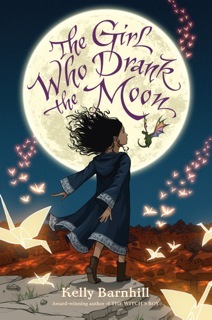
Below are writing lessons for the classroom or for individual writers ages 8 and up. Barnhill’s website has a hilarious FAQ about her writing process and information on her other books.

CREATING CHARACTERS: Exploring Stereotype: Barnhill’s novel is full of witches, who are usually presented as problematic in most books. Witches often are the villains or antagonists in fairy tales, for example. Barnhill said that she wanted to push beyond the usual stereotype of the witch as mean (even evil), old, homely, and solitary. Her witch characters are unique individuals, with a mix of positive and negative traits.
Classroom Discussion: Have kids read the novel and make a list of the positive and negative traits for some of the witches.
Classroom Discussion and Writing: Have students think about a character in a fairy tale or story that is usually presented in a stereotyped way. The wolf in “The Three Little Pigs” or “Little Red Riding Hood,” is an example of a character that is usually presented only with negative traits. The princess (“Cinderella,” “Snow White”) is usually presented with only positive traits. Ask students to read their fairy tale carefully and list traits of this character or what they learn about the character from this tale. Then ask them to give this character 1 or 2 traits that are the opposite of what they listed. For example, the wolf might be listed as “nurturing” or Cinderella as “lazy.” Ask students to write a story or even just a short scene to show this character with at least one positive and one negative trait.
An Unexpected Character: We usually think of dragons as large fierce characters but the young witch’s pet in Barnhill’s novel is a tiny bossy dragon. Classroom Discussion: Ask kids to list some the physical and psychological traits of one of their favorite animals. Then ask them to change one or two of the traits to its opposite (for example, from “big” to “small” of from “cuddly” to “fierce”), and in this way the character becomes fresh and unexpected. Classroom Writing: Ask students to create a story about or that includes such an unexpected pet. Perhaps the unexpected pet is even the main character! What happens next?
Ask a few students to volunteer to read their pieces aloud. As a group, discuss what they learned about creating more nuanced or well-rounded characters and unexpected pets.
www.maryquattlebaum.com
Kelly Barnhill’s atmospheric novel The Girl Who Drank the Moon won this year’s Newbery Medal. In an interview with the KidsPost section of the Washington Post, Barnhill talks about trying to create nuanced characters and her desire for a pet dragon as a kid.

Below are writing lessons for the classroom or for individual writers ages 8 and up. Barnhill’s website has a hilarious FAQ about her writing process and information on her other books.

CREATING CHARACTERS: Exploring Stereotype: Barnhill’s novel is full of witches, who are usually presented as problematic in most books. Witches often are the villains or antagonists in fairy tales, for example. Barnhill said that she wanted to push beyond the usual stereotype of the witch as mean (even evil), old, homely, and solitary. Her witch characters are unique individuals, with a mix of positive and negative traits.
Classroom Discussion: Have kids read the novel and make a list of the positive and negative traits for some of the witches.
Classroom Discussion and Writing: Have students think about a character in a fairy tale or story that is usually presented in a stereotyped way. The wolf in “The Three Little Pigs” or “Little Red Riding Hood,” is an example of a character that is usually presented only with negative traits. The princess (“Cinderella,” “Snow White”) is usually presented with only positive traits. Ask students to read their fairy tale carefully and list traits of this character or what they learn about the character from this tale. Then ask them to give this character 1 or 2 traits that are the opposite of what they listed. For example, the wolf might be listed as “nurturing” or Cinderella as “lazy.” Ask students to write a story or even just a short scene to show this character with at least one positive and one negative trait.
An Unexpected Character: We usually think of dragons as large fierce characters but the young witch’s pet in Barnhill’s novel is a tiny bossy dragon. Classroom Discussion: Ask kids to list some the physical and psychological traits of one of their favorite animals. Then ask them to change one or two of the traits to its opposite (for example, from “big” to “small” of from “cuddly” to “fierce”), and in this way the character becomes fresh and unexpected. Classroom Writing: Ask students to create a story about or that includes such an unexpected pet. Perhaps the unexpected pet is even the main character! What happens next?
Ask a few students to volunteer to read their pieces aloud. As a group, discuss what they learned about creating more nuanced or well-rounded characters and unexpected pets.
www.maryquattlebaum.com
Published on June 19, 2017 14:00
June 12, 2017
7 ATE 9: THE UNTOLD STORY
by Laura Gehl
7 Ate 9: The Untold Story, written by Tara Lazar and illustrated by Ross MacDonald, is a clever mystery and a great book to read aloud in your classroom.

After you read 7 Ate 9 to your students, you can use it as a fun writing prompt for the classroom. Here are a few writing suggestions:
1) The author, Tara Lazar, took an old joke (“Why is 6 afraid of 7?” “Because 7 ate/8 9!”) and turned it into the plot of a book. Can you take a joke and turn it into a story? Use one of these jokes, or any other joke you like:-“Why did the chicken cross the road?” “To get to the other side!”-“How do you catch a fish without a fishing rod?” “You use your BEAR hands!”-“What is it called when a cat wins a dog show?” “A CAT-astrophe!”
2) This book is positively FILLED with puns and plays on words. Here are just a few:-Private “I”-I orders a slice of “pi” -7 is described as “odd”How many other puns and plays on words can you find in this book? Check the illustrations too! Make a list as a class.
3) 7 Ate 9 is a mystery story. Try writing your own mystery story. Before you start writing, organize your thoughts. How does the mystery begin? Is there a missing person or item? Who will solve the mystery in your story? What clues can you sprinkle into your story so that the mystery can be solved?
4) Ross MacDonald managed to draw numbers in a way that gives each one lots of personality. You try! Draw a number and give it hands, feet, and a face, like in the book. You can add clothes or any other touches you like. Now write a few sentences describing the personality of your number. What foods and activities does your number like? Dislike? Who are your number’s friends? Does your number have a pet?
5) Write your own ending to 7 Ate 9. Instead of 9 turning out to be 6, and 6 trying to frame 7…what else could happen? You decide! Think of a different solution to the mystery and write it down.
www.lauragehl.com
7 Ate 9: The Untold Story, written by Tara Lazar and illustrated by Ross MacDonald, is a clever mystery and a great book to read aloud in your classroom.

After you read 7 Ate 9 to your students, you can use it as a fun writing prompt for the classroom. Here are a few writing suggestions:
1) The author, Tara Lazar, took an old joke (“Why is 6 afraid of 7?” “Because 7 ate/8 9!”) and turned it into the plot of a book. Can you take a joke and turn it into a story? Use one of these jokes, or any other joke you like:-“Why did the chicken cross the road?” “To get to the other side!”-“How do you catch a fish without a fishing rod?” “You use your BEAR hands!”-“What is it called when a cat wins a dog show?” “A CAT-astrophe!”
2) This book is positively FILLED with puns and plays on words. Here are just a few:-Private “I”-I orders a slice of “pi” -7 is described as “odd”How many other puns and plays on words can you find in this book? Check the illustrations too! Make a list as a class.
3) 7 Ate 9 is a mystery story. Try writing your own mystery story. Before you start writing, organize your thoughts. How does the mystery begin? Is there a missing person or item? Who will solve the mystery in your story? What clues can you sprinkle into your story so that the mystery can be solved?
4) Ross MacDonald managed to draw numbers in a way that gives each one lots of personality. You try! Draw a number and give it hands, feet, and a face, like in the book. You can add clothes or any other touches you like. Now write a few sentences describing the personality of your number. What foods and activities does your number like? Dislike? Who are your number’s friends? Does your number have a pet?
5) Write your own ending to 7 Ate 9. Instead of 9 turning out to be 6, and 6 trying to frame 7…what else could happen? You decide! Think of a different solution to the mystery and write it down.
www.lauragehl.com
Published on June 12, 2017 14:00
June 5, 2017
Time Capsules & Letter Writing
by Jacqueline Jules
In Abuela’s Special Letters, the irrepressible Sofia Martinez decides that her whole family, including her cousins and grandmother, should make a time capsule.

“Why?” Sofia’s youngest cousin asks.“So we can have fun in the future by looking at our past,” Sofia explains.
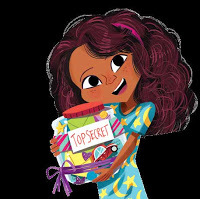
Time capsules are a creative way for young writers to capture the present and dream about the future. Read Abuela’s Secret Letters from the Sofia Martinez series with your students. Discuss how each child in the story wrote a one word description of themselves. Sofia called herself “curious.” What word would your students choose to describe themselves and why?
Ask your students to create a personal time capsule. This could be an end-of-the-year activity in which students reflect on the school year coming to a close and what they hope next year will bring. Time capsules are also a great way to start off in September with students writing down their predictions for the school year. Either way, ask you students to include answers to all or some of the following:
Favorite activity
Favorite food, song, color, TV show, game, etc.
Favorite School Subject
Favorite School Memory
Favorite Family Memory
Hopes for the Future
Three Personal Items & Why They Represent Who I Am Right Now
The Best Thing That Happened This Year
The Worst Thing That Happened This Year
What Makes Me Laugh
What Makes Me Cry
Places I Hope to See One Day
Time capsules can also be used to add writing to your social studies curriculum. Can your class make a time capsule for a historical figure like Benjamin Franklin or George Washington Carver? Could they make a time capsule for the Jamestown colony or Plymouth Rock? Time capsules provide many opportunities for imaginative learning and writing. No time capsule is complete without letters explaining the purpose of the objects included and other background information. Time capsules are also a great discussion starter for why it is important to preserve history. Your students could do research on time capsules and report on their findings. What did city officials bury in the cornerstone of important buildings? Do you agree with their choices? What items would you choose to represent your city?
And once students have finished their time capsules, they will enjoy decorating them. Creative learning is so much fun!
www.jacquelinejules.com
In Abuela’s Special Letters, the irrepressible Sofia Martinez decides that her whole family, including her cousins and grandmother, should make a time capsule.

“Why?” Sofia’s youngest cousin asks.“So we can have fun in the future by looking at our past,” Sofia explains.

Time capsules are a creative way for young writers to capture the present and dream about the future. Read Abuela’s Secret Letters from the Sofia Martinez series with your students. Discuss how each child in the story wrote a one word description of themselves. Sofia called herself “curious.” What word would your students choose to describe themselves and why?
Ask your students to create a personal time capsule. This could be an end-of-the-year activity in which students reflect on the school year coming to a close and what they hope next year will bring. Time capsules are also a great way to start off in September with students writing down their predictions for the school year. Either way, ask you students to include answers to all or some of the following:
Favorite activity
Favorite food, song, color, TV show, game, etc.
Favorite School Subject
Favorite School Memory
Favorite Family Memory
Hopes for the Future
Three Personal Items & Why They Represent Who I Am Right Now
The Best Thing That Happened This Year
The Worst Thing That Happened This Year
What Makes Me Laugh
What Makes Me Cry
Places I Hope to See One Day
Time capsules can also be used to add writing to your social studies curriculum. Can your class make a time capsule for a historical figure like Benjamin Franklin or George Washington Carver? Could they make a time capsule for the Jamestown colony or Plymouth Rock? Time capsules provide many opportunities for imaginative learning and writing. No time capsule is complete without letters explaining the purpose of the objects included and other background information. Time capsules are also a great discussion starter for why it is important to preserve history. Your students could do research on time capsules and report on their findings. What did city officials bury in the cornerstone of important buildings? Do you agree with their choices? What items would you choose to represent your city?
And once students have finished their time capsules, they will enjoy decorating them. Creative learning is so much fun!
www.jacquelinejules.com
Published on June 05, 2017 14:00
May 22, 2017
Writing Connections with Nick Bruel
by Mary Quattlebaum
Nick Bruel is the creator of highly popular chapter books, picture books and early readers, all of which feature his inimitable feline character Bad Kitty. In an interview with the KidsPost section of the Washington Post, Bruel talks about his latest book—Bad Kitty Takes the Test--the testing climate in schools, and combating test-stress through creativity and playfulness.

Bad Kitty Takesthe Test is a funny book, with chickens trying to sabotage the cats that are taking a standardized test to prove they are cats. There are graphics, dialogue balloons and even portions of the very odd test. Bruel’s aim is to help kids to laugh and take the whole testing-thing less seriously.
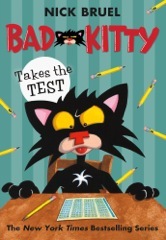
So, with the aim of being silly and having fun, below are some writing lessons for the classroom or for individual writers 8 and up. By poking fun at a serious issue (schools’ emphasis on standardized testing), Bruel helps both to defuse tension and highlight the negative effect on kids.
MAKING A GRAPHIC STORY: Classroom Discussion: After reading the book, ask kids about their feelings of stress and worry around standardized testing. Have them write down three things they dislike about the testing process. Talk about how Bad Kitty gets so frustrated that she refuses to take any more pretests. Classroom Writing: Have kids create their own animal or human character or work in pairs to do so. The character is going into school to take a standardized test. Encourage students to use dialogue balloons to directly show what the character is thinking and saying about the test. Does she or he express feelings to other characters that are about to take the test? What happens?
CREATING A SILLY TEST: Students have certainly taken enough pre- or practice tests to know the standard format. Have them create their own silly tests on a personal interest or passion (superheroes, dogs, chess, dance, swimming, etc.). For multiple-choice format, students might write 2 silly questions and 2 serious questions--and answers for all might be one correct answer and three obviously silly ones. Once they’ve designed their tests, students can have a friend, parent, or even the teacher take it. Much laughter will ensue.
MAKING A GRAPHIC STORY REDUX: JOURNALING THROUGH WORDS AND PICTURES: Encourage students to use this graphic-story format as a way of keeping a journal or exploring, in writing and drawing, the things that worry or stress them. First, have them identify, by listing on paper, one thing they feel stressed about at that point in time and why they feel stressed and how they deal with it. Let them know there is no right or wrong to this and encourage them to write about this in more detail and/or draw pictures. Students can also cut images from magazines and make a collage of their feelings, adding in their own drawings, as they wish. Students should not have to share unless they wish to do so. Ask them if they felt better just getting their feelings out and down on paper.
Additional Resources
Bruel’s website includes games and resources.
In Bad Kitty Drawn to Trouble, Bruel takes kids through the basic elements of story—and drawing--as he guides them to write their own story.
www.maryquattlebaum.com
Nick Bruel is the creator of highly popular chapter books, picture books and early readers, all of which feature his inimitable feline character Bad Kitty. In an interview with the KidsPost section of the Washington Post, Bruel talks about his latest book—Bad Kitty Takes the Test--the testing climate in schools, and combating test-stress through creativity and playfulness.

Bad Kitty Takesthe Test is a funny book, with chickens trying to sabotage the cats that are taking a standardized test to prove they are cats. There are graphics, dialogue balloons and even portions of the very odd test. Bruel’s aim is to help kids to laugh and take the whole testing-thing less seriously.

So, with the aim of being silly and having fun, below are some writing lessons for the classroom or for individual writers 8 and up. By poking fun at a serious issue (schools’ emphasis on standardized testing), Bruel helps both to defuse tension and highlight the negative effect on kids.
MAKING A GRAPHIC STORY: Classroom Discussion: After reading the book, ask kids about their feelings of stress and worry around standardized testing. Have them write down three things they dislike about the testing process. Talk about how Bad Kitty gets so frustrated that she refuses to take any more pretests. Classroom Writing: Have kids create their own animal or human character or work in pairs to do so. The character is going into school to take a standardized test. Encourage students to use dialogue balloons to directly show what the character is thinking and saying about the test. Does she or he express feelings to other characters that are about to take the test? What happens?
CREATING A SILLY TEST: Students have certainly taken enough pre- or practice tests to know the standard format. Have them create their own silly tests on a personal interest or passion (superheroes, dogs, chess, dance, swimming, etc.). For multiple-choice format, students might write 2 silly questions and 2 serious questions--and answers for all might be one correct answer and three obviously silly ones. Once they’ve designed their tests, students can have a friend, parent, or even the teacher take it. Much laughter will ensue.
MAKING A GRAPHIC STORY REDUX: JOURNALING THROUGH WORDS AND PICTURES: Encourage students to use this graphic-story format as a way of keeping a journal or exploring, in writing and drawing, the things that worry or stress them. First, have them identify, by listing on paper, one thing they feel stressed about at that point in time and why they feel stressed and how they deal with it. Let them know there is no right or wrong to this and encourage them to write about this in more detail and/or draw pictures. Students can also cut images from magazines and make a collage of their feelings, adding in their own drawings, as they wish. Students should not have to share unless they wish to do so. Ask them if they felt better just getting their feelings out and down on paper.
Additional Resources
Bruel’s website includes games and resources.
In Bad Kitty Drawn to Trouble, Bruel takes kids through the basic elements of story—and drawing--as he guides them to write their own story.
www.maryquattlebaum.com
Published on May 22, 2017 14:00
May 15, 2017
GETTING LOST WITH BOB AND JOSS
Guest Post by Peter McCleery
Getting lost is one of those universal experiences that everyone can relate to. We all have a “getting lost” story. School visits for Bob and Joss Get Lost, my debut book, have led to some very enthusiastic discussions about this topic with students. Not only are they eager to share their stories about getting lost but they LOVE to brainstorm ideas about where Bob and Joss should get lost on their next adventure.
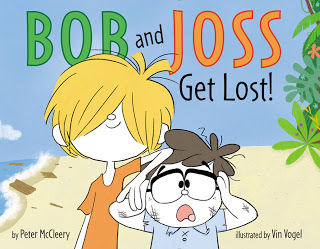
One of my favorite classroom writing activities is to get students brainstorming. For some students (and authors) deciding on what to write about can be very challenging. It’s a skill that often gets overlooked in writing assignments. It’s important that children have the space, time and freedom to answer the all-important “what if” question when coming up with ideas. And with Bob and Joss as a prompt, students can have a lot of fun getting lost in their ideas.
As a brainstorming writing exercise ask students to come up with a list of at least ten different ways or places that Bob and Joss can get lost on their next adventure. The more the better. Make it clear that there aren’t any limits to what they can imagine for these characters. I’ve had students suggest things from “in school” or “at the mall” to “in space,” and “in their brains.” (whatever that means!) It’s important to let them know that there are no wrong answers when brainstorming!
Have the students share some of their favorite ideas and list them on the board. Giggles are guaranteed! You could also use Bob and Joss as a starting point for a discussion about getting lost. Have students share real-life stories about a time when they got lost. Perhaps on a hike, or in a store, etc… Discuss what it felt like. Was it scary? Was it exciting? How did you feel when you got home? Relieved? Disappointed? This can also lead to a discussion about safety and what to do if they get lost.
Another aspect of Bob and Joss that proves useful in the classroom is an introduction to the geographic coordinates of latitude and longitude. Sharp eyed readers will notice that on each spread of the book there is the current location of the characters in coordinates. In fact, you can track their journey by putting the numbers into a digital map, like Google Maps. No spoilers here, but the numbers are real places on the earth! It’s a fun way to discuss mapping, coordinates and geography. You can even figure out exactly where your classroom is and write those coordinates on the board!
 BIO: Peter McCleery is the author of the hilarious Bob and Joss series of children's books, Bob and Joss Get Lost! (February 2017) and Bob and Joss Take a Hike! (coming in 2018). He lives with his wife and two children in Portland, Oregon where he occasionally gets lost. His favorite things include kids (and adults) who laugh. He’s also written for Highlights magazine and for grown-ups on the McSweeney’s humor website.
BIO: Peter McCleery is the author of the hilarious Bob and Joss series of children's books, Bob and Joss Get Lost! (February 2017) and Bob and Joss Take a Hike! (coming in 2018). He lives with his wife and two children in Portland, Oregon where he occasionally gets lost. His favorite things include kids (and adults) who laugh. He’s also written for Highlights magazine and for grown-ups on the McSweeney’s humor website.
You can find him at www.petermccleery.com, on Twitter: @pmccleery and on Facebook: @petermccleeryauthor
Getting lost is one of those universal experiences that everyone can relate to. We all have a “getting lost” story. School visits for Bob and Joss Get Lost, my debut book, have led to some very enthusiastic discussions about this topic with students. Not only are they eager to share their stories about getting lost but they LOVE to brainstorm ideas about where Bob and Joss should get lost on their next adventure.

One of my favorite classroom writing activities is to get students brainstorming. For some students (and authors) deciding on what to write about can be very challenging. It’s a skill that often gets overlooked in writing assignments. It’s important that children have the space, time and freedom to answer the all-important “what if” question when coming up with ideas. And with Bob and Joss as a prompt, students can have a lot of fun getting lost in their ideas.
As a brainstorming writing exercise ask students to come up with a list of at least ten different ways or places that Bob and Joss can get lost on their next adventure. The more the better. Make it clear that there aren’t any limits to what they can imagine for these characters. I’ve had students suggest things from “in school” or “at the mall” to “in space,” and “in their brains.” (whatever that means!) It’s important to let them know that there are no wrong answers when brainstorming!
Have the students share some of their favorite ideas and list them on the board. Giggles are guaranteed! You could also use Bob and Joss as a starting point for a discussion about getting lost. Have students share real-life stories about a time when they got lost. Perhaps on a hike, or in a store, etc… Discuss what it felt like. Was it scary? Was it exciting? How did you feel when you got home? Relieved? Disappointed? This can also lead to a discussion about safety and what to do if they get lost.
Another aspect of Bob and Joss that proves useful in the classroom is an introduction to the geographic coordinates of latitude and longitude. Sharp eyed readers will notice that on each spread of the book there is the current location of the characters in coordinates. In fact, you can track their journey by putting the numbers into a digital map, like Google Maps. No spoilers here, but the numbers are real places on the earth! It’s a fun way to discuss mapping, coordinates and geography. You can even figure out exactly where your classroom is and write those coordinates on the board!
 BIO: Peter McCleery is the author of the hilarious Bob and Joss series of children's books, Bob and Joss Get Lost! (February 2017) and Bob and Joss Take a Hike! (coming in 2018). He lives with his wife and two children in Portland, Oregon where he occasionally gets lost. His favorite things include kids (and adults) who laugh. He’s also written for Highlights magazine and for grown-ups on the McSweeney’s humor website.
BIO: Peter McCleery is the author of the hilarious Bob and Joss series of children's books, Bob and Joss Get Lost! (February 2017) and Bob and Joss Take a Hike! (coming in 2018). He lives with his wife and two children in Portland, Oregon where he occasionally gets lost. His favorite things include kids (and adults) who laugh. He’s also written for Highlights magazine and for grown-ups on the McSweeney’s humor website. You can find him at www.petermccleery.com, on Twitter: @pmccleery and on Facebook: @petermccleeryauthor
Published on May 15, 2017 14:00
May 8, 2017
It’s All in the Details
by Karen Leggett Abouraya
I remember my high school biology teacher years ago assigning each of us a square yard of ground near the football field. We were to record every bit of life we could find. We expected the assignment to take no time at all since most of our patches were little more than scruffy dirt. Or were they? Look at that blade of grass. And is that an almost microscopic bug climbing up the dandelion? There was life in that square if we looked closely.
It’s all in the details.
Details are key to colorful, descriptive writing and illustrating, as in the picture book Prairie Dog Song by Susan L. Roth and Cindy Trumbore (Lee and Low, 2016). Prairie dog tunnels “connect to a maze of rooms. Some rooms are for listening for predators, enemies that eat prairie dogs. Other rooms are used for sleeping, storing food, and raising playful prairie dog pups. Another room is a toilet area.”

The story of the prairie dog ecosystem is also told in verse, written to the tune of the old folk song, “The Green Grass Grows All Around.”
“And down those holesLived prairie dogs,With the friskiest pupsThat you ever did see.Yes, the prairie dogs builtTheir homes in the ground.And the grasses wavedAll around, all around,And the grasses waved all around.”
Spring is a perfect time of year to take advantage of writing prompts suggested by nature. Susan Roth and Cindy Trumbore traveled to New Mexico because, said Susan, “we both HAD to see the real prairie dogs and the grasses and the skies in the west.” Take children outside so they can see the real animals and grasses and skies - and provide several optional writing or drawing prompts.
· We think grass is green – just like the folk song. But look at the blades of grass in Prairie Dog Song. Illustrator Susan L. Roth thinks she may have cut fifty billion blades of grass for her collages! And they are brown, yellow, reddish and many shades of green. Look at real grass or real leaves: draw and color all the different shades and shapes you see.
· Write a paragraph about a patch of grass or woodland. Describe everything you see in detail so that a reader can truly imagine its colors, shapes and movement.
· Imagine and write a story about a shape in the clouds.
· Take a photograph or draw a bug or a flower. Try to identify it through good Internet or library research and write a paragraph about your find. Add colorful details to your photo or drawing. Speaking of details, did you know Susan Roth glued freshly ground coffee on the buffalo to make its rich brown fur look matted?
· In Prairie Dog Song, ferrets are predators and prairie dogs are prey. What are some predators and prey you can see where you are sitting or walking outside? Write a paragraph from the point of view of the prey. What could you do to escape or hide?
· Write lyrics about what you see outdoors using the rhyming pattern and rhythm of a simple, favorite song. This could be a good project for a whole class, with everyone offering details for the lyrics and then singing together at the end. “And the grasses waved/All around, all around/And the grasses waved all around.”

https://childrensbookguild.org/karen-...
I remember my high school biology teacher years ago assigning each of us a square yard of ground near the football field. We were to record every bit of life we could find. We expected the assignment to take no time at all since most of our patches were little more than scruffy dirt. Or were they? Look at that blade of grass. And is that an almost microscopic bug climbing up the dandelion? There was life in that square if we looked closely.
It’s all in the details.
Details are key to colorful, descriptive writing and illustrating, as in the picture book Prairie Dog Song by Susan L. Roth and Cindy Trumbore (Lee and Low, 2016). Prairie dog tunnels “connect to a maze of rooms. Some rooms are for listening for predators, enemies that eat prairie dogs. Other rooms are used for sleeping, storing food, and raising playful prairie dog pups. Another room is a toilet area.”

The story of the prairie dog ecosystem is also told in verse, written to the tune of the old folk song, “The Green Grass Grows All Around.”
“And down those holesLived prairie dogs,With the friskiest pupsThat you ever did see.Yes, the prairie dogs builtTheir homes in the ground.And the grasses wavedAll around, all around,And the grasses waved all around.”
Spring is a perfect time of year to take advantage of writing prompts suggested by nature. Susan Roth and Cindy Trumbore traveled to New Mexico because, said Susan, “we both HAD to see the real prairie dogs and the grasses and the skies in the west.” Take children outside so they can see the real animals and grasses and skies - and provide several optional writing or drawing prompts.
· We think grass is green – just like the folk song. But look at the blades of grass in Prairie Dog Song. Illustrator Susan L. Roth thinks she may have cut fifty billion blades of grass for her collages! And they are brown, yellow, reddish and many shades of green. Look at real grass or real leaves: draw and color all the different shades and shapes you see.
· Write a paragraph about a patch of grass or woodland. Describe everything you see in detail so that a reader can truly imagine its colors, shapes and movement.
· Imagine and write a story about a shape in the clouds.
· Take a photograph or draw a bug or a flower. Try to identify it through good Internet or library research and write a paragraph about your find. Add colorful details to your photo or drawing. Speaking of details, did you know Susan Roth glued freshly ground coffee on the buffalo to make its rich brown fur look matted?
· In Prairie Dog Song, ferrets are predators and prairie dogs are prey. What are some predators and prey you can see where you are sitting or walking outside? Write a paragraph from the point of view of the prey. What could you do to escape or hide?
· Write lyrics about what you see outdoors using the rhyming pattern and rhythm of a simple, favorite song. This could be a good project for a whole class, with everyone offering details for the lyrics and then singing together at the end. “And the grasses waved/All around, all around/And the grasses waved all around.”

https://childrensbookguild.org/karen-...
Published on May 08, 2017 14:00
May 1, 2017
Heroes and Historical Fiction – The Six-Day Hero
Guest post by Tammar Stein
The Six-Day Herotells the story of Motti, a scrappy 12-year-old Israeli boy living in Israel on the eve of the Six-Day War. Idolizing his older brother, a soldier in the Israeli Defense Force, Motti dreams of being a hero. As the Six-Day War begins and his brother is called up to fight, Motti realizes that war isn’t a game. Motti knows his older brother is a hero, but through the six days that will decide Israel’s fate, he discovers other heroes in surprising places. He may even be a hero himself.
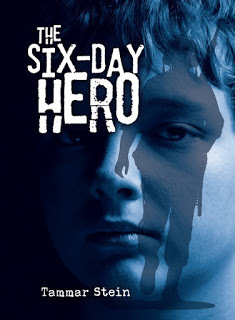
In 1967, Israel teetered between existence and annihilation. By winning the Six Day War, it averted annihilation…and began the modern dilemma of the Israeli occupation of the West Bank and the Gaza Strip. This summer (June 5-11) marks the war’s 50th anniversary.
I wrote The Six-Day Hero after discovering there was nothing on the topic for Middle Grade readers. Well-researched historical fiction can open a door into the past. By letting readers feel what those historical events were like, not just dry facts like places and dates, but also sounds, smells, tastes, and emotions, history sudden leaps to life.
Because historical fiction can be the doorway to understanding historical events, I felt that I had a responsibility to make sure my facts were correct. The plot and the characters are fictional. But the facts in The Six-Day Hero are all real. The order of events leading up to the war and during the war are true. The quotes from foreign leaders on the radio are true. Even the color of the public bus that the boys ride is historically accurate. In order to make sure that each fact in the book was correct, I read nonfiction books, pulled newspaper articles from the time period and interviewed a dozen Israelis and Americans who had lived through the Six Day War.
Reading The Six-Day Hero is a wonderful way to introduce current events into your curriculum. The Six Day War happened 50 years ago. That probably seems like ancient history to your students. But since this is the war that started the situation of the West Bank and Gaza Strip, it still has a big effect on millions of people. It’s not ancient history, it’s current events.
Ask your students to find Israel on the map. Have them find Egypt, Jordan and Syria. Find Morocco and Tunisia. Compare them to the United States. Notice their size difference and their distance from each other. Discuss whether a country’s size correlates to its influence. What are some reasons that countries go to war? What are the risks and rewards of war? What are the risks and rewards to refusing to fight? Ask your students to write an essay on one of these topics.
Ask your students to collect newspaper articles and do research on a place frequently mentioned in the news. Could they create a character sketch of a fictional person who lives in this place? Could they write a description of the setting?
Discuss the differences between fiction and non-fiction. Between plot (fiction) and setting (which could be fiction or non-fiction). Ask students to name examples of fictional settings and non-fictional settings. Discuss the novel and have your students separate fact and fiction. Knowing that the historical facts are correct, where is the fiction?
Books can open new worlds to us. They can introduce us to distant lands and make us feel kinship with strangers. I hope your students walk away from The Six-Day Hero with a new appreciation that behind every news story is a story of people.
 Tammar Stein is the author of four young adult novels, including Light Years, an American Libraries Association Best Book of the Year, a Virginia Reader’s Choice, and a Texas Summer Reading List book. The Six-Day Hero is her first Middle Grade novel. It is a Junior Library Guild Selection. You can visit Tammar at www.tammarstein.com
Tammar Stein is the author of four young adult novels, including Light Years, an American Libraries Association Best Book of the Year, a Virginia Reader’s Choice, and a Texas Summer Reading List book. The Six-Day Hero is her first Middle Grade novel. It is a Junior Library Guild Selection. You can visit Tammar at www.tammarstein.com
The Six-Day Herotells the story of Motti, a scrappy 12-year-old Israeli boy living in Israel on the eve of the Six-Day War. Idolizing his older brother, a soldier in the Israeli Defense Force, Motti dreams of being a hero. As the Six-Day War begins and his brother is called up to fight, Motti realizes that war isn’t a game. Motti knows his older brother is a hero, but through the six days that will decide Israel’s fate, he discovers other heroes in surprising places. He may even be a hero himself.

In 1967, Israel teetered between existence and annihilation. By winning the Six Day War, it averted annihilation…and began the modern dilemma of the Israeli occupation of the West Bank and the Gaza Strip. This summer (June 5-11) marks the war’s 50th anniversary.
I wrote The Six-Day Hero after discovering there was nothing on the topic for Middle Grade readers. Well-researched historical fiction can open a door into the past. By letting readers feel what those historical events were like, not just dry facts like places and dates, but also sounds, smells, tastes, and emotions, history sudden leaps to life.
Because historical fiction can be the doorway to understanding historical events, I felt that I had a responsibility to make sure my facts were correct. The plot and the characters are fictional. But the facts in The Six-Day Hero are all real. The order of events leading up to the war and during the war are true. The quotes from foreign leaders on the radio are true. Even the color of the public bus that the boys ride is historically accurate. In order to make sure that each fact in the book was correct, I read nonfiction books, pulled newspaper articles from the time period and interviewed a dozen Israelis and Americans who had lived through the Six Day War.
Reading The Six-Day Hero is a wonderful way to introduce current events into your curriculum. The Six Day War happened 50 years ago. That probably seems like ancient history to your students. But since this is the war that started the situation of the West Bank and Gaza Strip, it still has a big effect on millions of people. It’s not ancient history, it’s current events.
Ask your students to find Israel on the map. Have them find Egypt, Jordan and Syria. Find Morocco and Tunisia. Compare them to the United States. Notice their size difference and their distance from each other. Discuss whether a country’s size correlates to its influence. What are some reasons that countries go to war? What are the risks and rewards of war? What are the risks and rewards to refusing to fight? Ask your students to write an essay on one of these topics.
Ask your students to collect newspaper articles and do research on a place frequently mentioned in the news. Could they create a character sketch of a fictional person who lives in this place? Could they write a description of the setting?
Discuss the differences between fiction and non-fiction. Between plot (fiction) and setting (which could be fiction or non-fiction). Ask students to name examples of fictional settings and non-fictional settings. Discuss the novel and have your students separate fact and fiction. Knowing that the historical facts are correct, where is the fiction?
Books can open new worlds to us. They can introduce us to distant lands and make us feel kinship with strangers. I hope your students walk away from The Six-Day Hero with a new appreciation that behind every news story is a story of people.
 Tammar Stein is the author of four young adult novels, including Light Years, an American Libraries Association Best Book of the Year, a Virginia Reader’s Choice, and a Texas Summer Reading List book. The Six-Day Hero is her first Middle Grade novel. It is a Junior Library Guild Selection. You can visit Tammar at www.tammarstein.com
Tammar Stein is the author of four young adult novels, including Light Years, an American Libraries Association Best Book of the Year, a Virginia Reader’s Choice, and a Texas Summer Reading List book. The Six-Day Hero is her first Middle Grade novel. It is a Junior Library Guild Selection. You can visit Tammar at www.tammarstein.com
Published on May 01, 2017 14:00
April 24, 2017
Ready for Inspiration? Try Balloons Lit. Journal
by Jacqueline Jules
I was first introduced to Balloons Lit. Journal in 2015 when I saw a call for submissions for Issue 2. Investigating further, I was pleased to find a beautifully designed online magazine of writing and art. This rich resource is appropriate for a wide audience and features authors from all over the world, including student writers. As an educator myself, I am immediately drawn to how this magazine could be a boost to classroom instruction. The first selection, “The Best Poem You’ll Ever Read” is followed by a challenge to the reader to write his or her own poem.
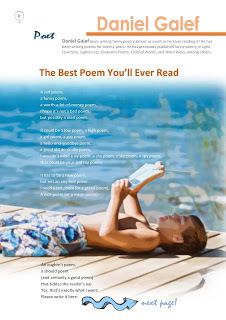
So many pieces in this issue would make excellent classroom writing prompts. “Message from a Stone Buddha to Izzy and Benjamin” is a delightfully clever letter from a garden statue. Using this piece as a model, classroom teachers could ask students to write their own letter to a person from an inanimate object.

An inspirational short fiction, “From Chopin’s Memoirs” could spark meaningful discussions of how to get through hard times. The imagery in this story is profound—reminding us that we must use all the keys of a piano, both black and white, “to play a beautiful tune.”
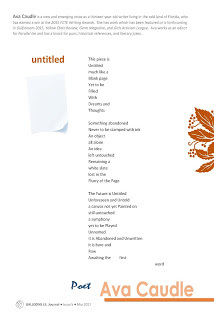 “Untitled” by thirteen-year-old Ava Caudle lyrically compares a blank canvas to “a symphony yet to be played,” capturing the emotional sphere of every young person contemplating the future. The inclusion of student authors alongside adult writers makes Balloons Lit. Journal an especially unique publication. And if one did not read the bylines carefully, the reader might not be able to identify work created by young people rather than adults. All the selections are thoughtful and finely tuned.
“Untitled” by thirteen-year-old Ava Caudle lyrically compares a blank canvas to “a symphony yet to be played,” capturing the emotional sphere of every young person contemplating the future. The inclusion of student authors alongside adult writers makes Balloons Lit. Journal an especially unique publication. And if one did not read the bylines carefully, the reader might not be able to identify work created by young people rather than adults. All the selections are thoughtful and finely tuned.
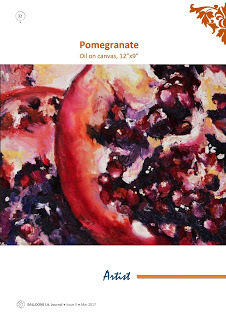
The dynamic artwork in this issue is not to be missed—particularly Alexandra Bowman’s oil on canvas “Pomegranate” and Sam McCready’s acrylic on paper, “Evening Trees.” I can see using these images as prompts in both writing and art classrooms.
Like previous issues of Balloons Lit. Journal, Issue 5 is a visual and textual cornucopia. Every reader will find something to love. Check out this magazine, available online. Take the time to enjoy it from cover to cover. You will be uplifted by the variety and depth of the material included. And like the last piece in this issue, “Take the Time to Dream,” you will be tempted “to lose yourself in clouds and sky” where your own creativity will soar.
www.jacquelinejules.com
I was first introduced to Balloons Lit. Journal in 2015 when I saw a call for submissions for Issue 2. Investigating further, I was pleased to find a beautifully designed online magazine of writing and art. This rich resource is appropriate for a wide audience and features authors from all over the world, including student writers. As an educator myself, I am immediately drawn to how this magazine could be a boost to classroom instruction. The first selection, “The Best Poem You’ll Ever Read” is followed by a challenge to the reader to write his or her own poem.

So many pieces in this issue would make excellent classroom writing prompts. “Message from a Stone Buddha to Izzy and Benjamin” is a delightfully clever letter from a garden statue. Using this piece as a model, classroom teachers could ask students to write their own letter to a person from an inanimate object.

An inspirational short fiction, “From Chopin’s Memoirs” could spark meaningful discussions of how to get through hard times. The imagery in this story is profound—reminding us that we must use all the keys of a piano, both black and white, “to play a beautiful tune.”
 “Untitled” by thirteen-year-old Ava Caudle lyrically compares a blank canvas to “a symphony yet to be played,” capturing the emotional sphere of every young person contemplating the future. The inclusion of student authors alongside adult writers makes Balloons Lit. Journal an especially unique publication. And if one did not read the bylines carefully, the reader might not be able to identify work created by young people rather than adults. All the selections are thoughtful and finely tuned.
“Untitled” by thirteen-year-old Ava Caudle lyrically compares a blank canvas to “a symphony yet to be played,” capturing the emotional sphere of every young person contemplating the future. The inclusion of student authors alongside adult writers makes Balloons Lit. Journal an especially unique publication. And if one did not read the bylines carefully, the reader might not be able to identify work created by young people rather than adults. All the selections are thoughtful and finely tuned.
The dynamic artwork in this issue is not to be missed—particularly Alexandra Bowman’s oil on canvas “Pomegranate” and Sam McCready’s acrylic on paper, “Evening Trees.” I can see using these images as prompts in both writing and art classrooms.

Like previous issues of Balloons Lit. Journal, Issue 5 is a visual and textual cornucopia. Every reader will find something to love. Check out this magazine, available online. Take the time to enjoy it from cover to cover. You will be uplifted by the variety and depth of the material included. And like the last piece in this issue, “Take the Time to Dream,” you will be tempted “to lose yourself in clouds and sky” where your own creativity will soar.
www.jacquelinejules.com
Published on April 24, 2017 14:00
April 17, 2017
Charlotte The Scientist
by Laura Gehl
Charlotte The Scientist Is Squished, by Camille Andros, illustrated by Brianne Farley, is a cute bunny story with adorable illustrations appropriate for very young kids. But Charlotte The Scientist Is Squished is also way more than that. Charlotte uses the scientific method in trying to solve problems, which provides a fun way to introduce the steps of the scientific method to elementary school students. Charlotte is also a strong, powerful girl who will remind kids of any age that girls can be scientists, mathematicians, or engineers…and that girls are problem-solvers in whatever careers they choose.

Charlotte The Scientist Is Squishedmakes an excellent writing prompt for the classroom. After you read Charlotte out loud to your students, here are a few suggestions to get kids writing:
1) Scientists try to find the answers to important questions. If you were a scientist, what questions would YOU want to answer?
2) Do you ever feel squished at home, at school, on the bus, or in other parts of your life? Write about when you feel squished. Or, if you never feel squished in real life, imagine when you might feel squished….when you and all your friends try to cram into a closet when you are playing hide and seek? When you and your eight dogs (remember…you are imagining this, so you can have as many dogs as you want!) try to fit in one sleeping bag on a camping trip?
3) Do you have anyplace in your life where you have your own space? Describe it. Or, design the perfect place where you could have your own space. Would it be a private island? A treehouse? A boat?
4) Camille and Brianne are working on a sequel to Charlotte The Scientist is Squished. If you were writing the next book about Charlotte, what would happen? What discoveries might Charlotte make? What problems might she try to solve?
5) What if you were illustrating the next Charlotte book…what changes would you make in the sequel? Would you give Charlotte a new lab coat? Different safety goggles? Cool earrings? Rubber boots? How would you make your pictures of Charlotte stand out?
www.lauragehl.com
Charlotte The Scientist Is Squished, by Camille Andros, illustrated by Brianne Farley, is a cute bunny story with adorable illustrations appropriate for very young kids. But Charlotte The Scientist Is Squished is also way more than that. Charlotte uses the scientific method in trying to solve problems, which provides a fun way to introduce the steps of the scientific method to elementary school students. Charlotte is also a strong, powerful girl who will remind kids of any age that girls can be scientists, mathematicians, or engineers…and that girls are problem-solvers in whatever careers they choose.

Charlotte The Scientist Is Squishedmakes an excellent writing prompt for the classroom. After you read Charlotte out loud to your students, here are a few suggestions to get kids writing:
1) Scientists try to find the answers to important questions. If you were a scientist, what questions would YOU want to answer?
2) Do you ever feel squished at home, at school, on the bus, or in other parts of your life? Write about when you feel squished. Or, if you never feel squished in real life, imagine when you might feel squished….when you and all your friends try to cram into a closet when you are playing hide and seek? When you and your eight dogs (remember…you are imagining this, so you can have as many dogs as you want!) try to fit in one sleeping bag on a camping trip?
3) Do you have anyplace in your life where you have your own space? Describe it. Or, design the perfect place where you could have your own space. Would it be a private island? A treehouse? A boat?
4) Camille and Brianne are working on a sequel to Charlotte The Scientist is Squished. If you were writing the next book about Charlotte, what would happen? What discoveries might Charlotte make? What problems might she try to solve?
5) What if you were illustrating the next Charlotte book…what changes would you make in the sequel? Would you give Charlotte a new lab coat? Different safety goggles? Cool earrings? Rubber boots? How would you make your pictures of Charlotte stand out?
www.lauragehl.com
Published on April 17, 2017 14:00
Mary Quattlebaum's Blog
- Mary Quattlebaum's profile
- 22 followers
Mary Quattlebaum isn't a Goodreads Author
(yet),
but they
do have a blog,
so here are some recent posts imported from
their feed.



